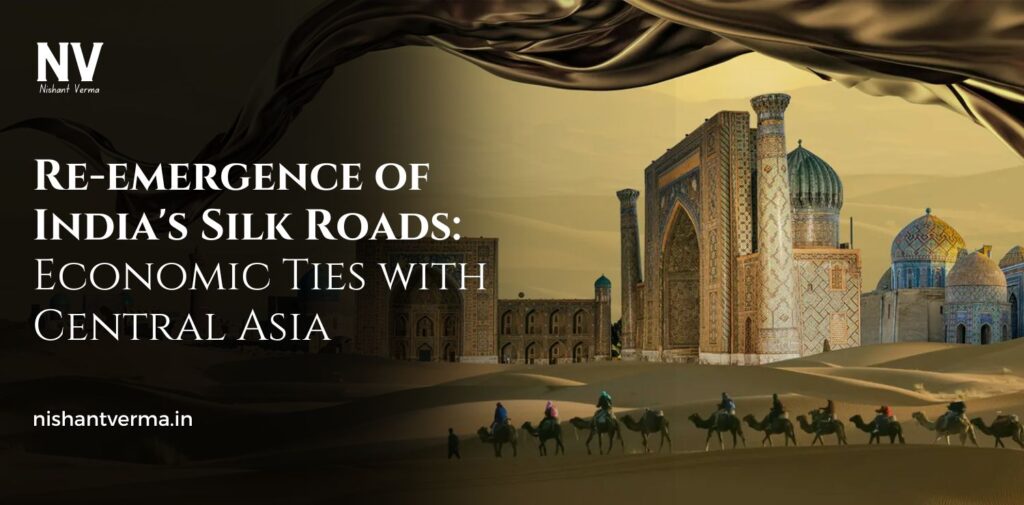India’s historical connections to Central Asia go back many centuries, rooted in the exchanges of culture, religion, and trade that flourished along the ancient Silk Roads. These trade routes once linked India with the Far East, the Middle East, and Europe, facilitating not only the exchange of goods but also ideas, technologies, and philosophies. However, in modern times, these connections waned due to political changes, geographical barriers, and shifting global priorities. In recent years, however, India has been working to re-establish its ties with Central Asia, driven by economic, strategic, and geopolitical factors. The re-emergence of India Silk Roads is shaping a new chapter in India’s economic and diplomatic relations with Central Asia.
Historical Context: The Ancient Silk Road and India’s Central Asian Ties
To understand the importance of the re-emergence of India Silk Roads, it’s essential to look back at history. The ancient Silk Road was not just one route but a network of trade routes that connected the East and the West, facilitating the exchange of goods like silk, spices, precious stones, and textiles. These routes passed through Central Asia, and India played a key role in the exchange. Indian merchants, scholars, and religious figures traveled to Central Asia, spreading not only goods but also cultural influences, especially Buddhism.
Indian influence in Central Asia during ancient times was significant. The Kushan Empire, which ruled large parts of Central Asia and the Indian subcontinent, was a crucial link between the Indian subcontinent and Central Asia. This historical relationship created a foundation of mutual respect and shared interests that India is now revisiting as it seeks to re-establish deeper ties with Central Asia.

The Geopolitical Importance of Central Asia for India
In the 21st century, India’s re-engagement with Central Asia is not just about trade, but also about geopolitical and strategic interests. Central Asia holds significant geopolitical importance because of its strategic location at the crossroads of Europe, Asia, and the Middle East. It is a region rich in natural resources, including oil, gas, and minerals, making it a key area for energy security. Moreover, the countries of Central Asia share borders with major global powers like Russia, China, and Iran, which makes the region a focal point of international relations.
India’s renewed interest in Central Asia is, in part, a response to the growing influence of China and Russia in the region. China, with its Belt and Road Initiative (BRI), has been expanding its economic footprint in Central Asia by building infrastructure and increasing trade. Russia has historically had strong ties with Central Asian countries and remains an influential player in the region. India’s engagement with Central Asia helps balance these influences and allows India to expand its sphere of influence in the heart of Asia.
Economic Opportunities in Central Asia
Central Asia offers India a wealth of economic opportunities, particularly in the fields of energy, trade, and investment. India’s growing energy needs make the region’s vast oil and natural gas reserves attractive. India has increasingly looked to Central Asia as a potential partner for energy resources, given the region’s proximity and rich reserves. India’s energy companies have started to explore oil and gas exploration partnerships with countries like Kazakhstan and Turkmenistan.
Beyond energy, Central Asia is an emerging market for Indian goods and services. With its growing consumer base, demand for infrastructure, and improving business environment, the region holds significant potential for Indian businesses. India has already begun to export a variety of goods, including textiles, pharmaceuticals, and machinery, to Central Asian markets. Additionally, India’s strong IT and service sectors can find new opportunities in the region, particularly as Central Asian countries seek to modernize their economies and develop their digital infrastructure.
The potential for trade is vast, and India’s engagement with the region through initiatives such as the International North-South Transport Corridor (INSTC) aims to establish more efficient trade routes. This corridor will connect India to Central Asia and beyond, bypassing traditional sea routes and cutting down transit times and costs. This initiative also allows India to strengthen its trade links with Europe and the Middle East, expanding its access to global markets.

Cultural and Educational Ties: Reviving the Silk Roads’ Legacy
Economic ties are not the only focus of India’s engagement with Central Asia. The historical cultural and educational links between the two regions are also being revived. India’s cultural diplomacy plays a crucial role in strengthening its ties with Central Asia. Shared historical and cultural roots, particularly the spread of Buddhism and ancient trade practices, provide a foundation for these renewed connections.
India has undertaken several initiatives to promote cultural exchanges with Central Asia. India’s government has supported initiatives to establish cultural centers, organize festivals, and promote Indian art and literature in the region. The Indian Council for Cultural Relations (ICCR) has been actively involved in fostering cultural understanding through scholarships, cultural exchange programs, and language courses in the region.
Moreover, India’s educational sector has played a crucial role in strengthening ties. Central Asian students have been studying in Indian universities for decades, and the number of students from the region coming to India for higher education continues to grow. India’s educational expertise, particularly in fields such as medicine, engineering, and technology, is highly regarded in Central Asia. By offering scholarships and promoting academic exchanges, India is not only strengthening its ties with the youth of Central Asia but also creating lasting goodwill in the region.
Strategic Collaborations and Security Concerns
Along with economic and cultural exchanges, India is also enhancing its security and defense cooperation with Central Asian countries. The region has been historically prone to instability, with security concerns related to terrorism, extremism, and narcotics trafficking. India’s security ties with Central Asia are built on mutual concerns about these issues, and India has increasingly been working with countries like Uzbekistan, Tajikistan, and Kazakhstan to address these challenges.
India has provided training to Central Asian armed forces and police in counterterrorism and border security. Furthermore, India has been involved in peacekeeping and humanitarian operations in Afghanistan, a country that shares deep historical, cultural, and political ties with Central Asia. India’s cooperation with Central Asia in counterterrorism efforts strengthens the region’s security while also ensuring India’s own national security interests.
India’s relationship with Central Asia is also facilitated through its membership in organizations like the Shanghai Cooperation Organization (SCO), a regional security and economic organization that includes Russia, China, and several Central Asian countries. The SCO provides a platform for India to engage with Central Asia on security and economic issues, further deepening its ties with the region.

Challenges in Strengthening Ties with Central Asia
While India’s re-emergence in Central Asia is promising, there are challenges that need to be addressed. The primary challenge is the geographical distance between India and Central Asia, which makes trade and transportation more difficult compared to other regional powers like China and Russia. The lack of direct access to the region via land routes is a significant hurdle, but India’s participation in the INSTC project is an attempt to address this issue by creating alternative transport corridors.
Another challenge is the competition from China, which has already made significant investments in the region through its Belt and Road Initiative. China’s growing influence in Central Asia, especially in terms of infrastructure development and trade, means that India needs to increase its efforts to compete effectively. India’s strategic advantage lies in its soft power, historical connections, and focus on regional stability, but it will need to keep strengthening its economic and diplomatic efforts to match China’s presence.
Conclusion: Re-emergence of India Silk Roads
India’s renewed focus on Central Asia and the re-emergence of its Silk Roads are key components of the country’s broader foreign policy strategy in the 21st century. The region’s economic potential, coupled with its cultural and historical ties with India, presents numerous opportunities for both sides. While challenges exist, India’s efforts to strengthen ties with Central Asia through trade, cultural diplomacy, and security collaboration will likely shape the future of these relations.
As India continues to develop and expand its connections with Central Asia, it will not only enhance its economic growth but also contribute to the broader stability and prosperity of the region. The revival of the Silk Roads is not just about trade and commerce; it is a journey that brings nations together, fosters mutual understanding, and opens up new possibilities for cooperation in the modern world. India’s role in this revival promises a bright future for both India and Central Asia.




